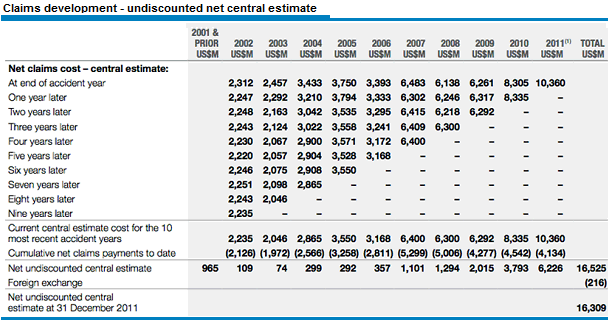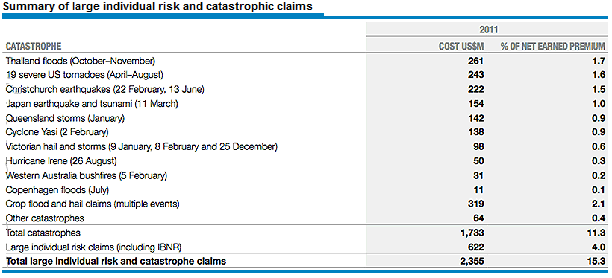Financial Services
-

MEDIA
What are Tim Kelley’s insights into the Australian Banks?
Tim Kelley
October 10, 2012

Do Ten Network (TEN), Seven West Media (SWM), Aurora Oil (AUT), Origin Energy (ORG), Santos (STO), Cedar Woods (CWP), Slater and Gordon (SGH), IMF (IMF), Roce Oil (ROC), The Reject Shop (TRS), Challenger (CGF), Bluescope (BSL) or Adelaide Brighton (ABC) achieve the coveted A1 grade? Watch this edition of Sky Business’ Your Money Your Call 10 October 2012 program now to find out, and also hear Tim’s thoughts on the big Aussie banks. Watch here.
by Tim Kelley Posted in Companies, Financial Services, Insightful Insights, TV Appearances.
-

MEDIA
What are Roger’s latest insights into Leighton’s and NAB?
Roger Montgomery
August 15, 2012
Roger provides his Value.able insights into Leighton Holdings (LEI) and National Australia Bank (NAB) to Ticky Fullerton in this edition of ABC1’s “The Business” braodcast 14 August 2012. Watch here.
by Roger Montgomery Posted in Companies, Financial Services, TV Appearances.
- save this article
- POSTED IN Companies, Financial Services, TV Appearances
-
The Weekly Kick Off: Is Australia THAT expensive?
Roger Montgomery
July 23, 2012
My Thoughts from the weekend:
A year ago we felt like Churchill – a voice in the wilderness – when we said Iron Ore prices could get ugly. On Friday they did….again. But more on that another time.
The number of overseas visitors we are meeting that tell us Sydney and Australia are “expensive” has got me thinking that Australians and Australia really needs to take advantage of the high Aussie dollar while it lasts.
Feeding ten people in Thailand at a local restaurant and ordering entree, mains and dessert for everyone as well as cocktails, beers, wine and mocktails for the kids amounts to 2000 baht or A$65.00. Thats a main course, a glass of water and a side of fries in Sydney. Its not surprising then to see so many Chinese, Russian and British tourists taking advantage of Thai hospitality.
Thinking about British investors; some have, over their lifetime, amassed, a million pounds. You would think that anyone in this position would be thinking “I’ve made it!” But they can now look forward to retirement with their next egg earning…wait for it… £7,500 per year! No wonder the UK student one of my colleagues is billeting here in Sydney has complained about how expensive Sydney is. The same might be said by Japanese tourists who are likewise earning less than 1% interest on their lifetime savings.
And last week I entertained two Singaporean investment professionals that couldn’t believe how expensive our harbour city had become for them. Coming from Singaporeans and Londoners, that’s really saying something.
These examples may only be anecdotes but my experience as an unconventional investor has taught me that aggregated anecdotes equals the whole.
Australia is uncompetitive.
I just bought a pair of italian shoes online and initially baulked before handing over my credit card details because the price was presented in Euros. But after doing the conversion I realised the depression in Spain (and it IS a depression) had opened another door for Australian shoppers looking for bargains (they have long enjoyed the bargains offered by the US). Additionally another nail has been driven into the coffins of Australia’s department stores.
It’s not often I can clearly see the headline many years in advance but unless our Australian dollar falls back to US70 cents the headlines will read: DJ’s and MYER are now in Run Off!!!!! Even a merger of the two wouldn’t help.
But hope for Australian retailers may be on the horizon. In the last week a consulting exploration geologist and an asset management consultant – both consulting to BHP, RIO, and others – have told me that projects are being shelved and deferred at a rapid pace. In some cases only from Q3 and Q4 to 2013 initially. In other cases, where the miners were shouting only six months ago (when we were writing our bearish opinions on Iron Ore and China); “get as many drills and people as you can, just get it done”, they are now saying “we may look at it again in a couple of years.”
Meantime American banks have been aggressive in cleaning up their banking system. The Economist notes that “the five biggest banks wrote off more almost $500 billion in the aftermath of the financial crisis and raised $318 billion in fresh capital.” No eurozone bank has yet set aside more than $30 billion.
In short I don’t believe a high Aussie dollar can be sustained – at least against the US (unless Agriculture can meet the slack from lower materials prices). And lest you want to be a tourist that complains of high prices when travelling abroad in the future, you need to think about how the above influences will impact your buying power.
The other thing that has caught my attention is the massive growth that will occur in superannuation. Currently there is $1.3 trillion and assuming certain growth rates, expect it to hit $4 trillion in fifteen years. The demographics will ensure that from 2028 (perhaps a couple of years later because of the change from 9% to 12% contributions) we will start seeing outflows putting pressure on inflows. But in the meantime the impact of this? Not enough high quality listed companies, prices of high quality listed companies being the only ones to sustain high price earnings multiples and lots of business for underwriters and Equity Capital Markets execs as a flood of baby boomers float their businesses to meet the tidal wave of superannuation money. Oh and expect a lot more investment into offshore stock markets and international fund managers like Magellan.
That latter point could be another reason to take advantage of a strong Aussie dollar now.
by Roger Montgomery Posted in Energy / Resources, Financial Services.
-
Co-ordinated easing – Chinese exports to slow?
Roger Montgomery
July 10, 2012
Early Friday morning Australian time saw coordinated easing from three of the World’s largest central banks. Firstly, the Bank of England raised their asset purchase target from GBP325 billion to GBP375 billion. Then the People’s Bank of China cut the one-year lending rate by 0.31 per cent to 6.0 per cent and the one-year deposit rate by 0.25 per cent to 3.0 per cent. China’s June Quarter GDP data is due out this Friday 13 July. Finally, the European Central Bank cut its main rate by 0.25 per cent to a record low 0.75 per cent.
ECB President Mario Draghi told reporters risk to the outlook remain “on the downside”. The European Union is China’s largest export market. At some stage this slowdown will weigh on China’s exports, which account for 40% of its GDP.
by Roger Montgomery Posted in Financial Services, Market Valuation.
-
What do the most widely held stocks in Australia all have in common?
Roger Montgomery
June 29, 2012
EXCLUSIVE CONTENT
subscribe for free
or sign in to access the articleby Roger Montgomery Posted in Financial Services, Skaffold, Value.able.
- 9 Comments
- save this article
- POSTED IN Financial Services, Skaffold, Value.able
-

MEDIA
Will Perpetual recapture the glory days?
Roger Montgomery
June 25, 2012
With 580 jobs to go, Perpetual is attempting to cut its way back to exceptional performance – however Roger Montgomery discusses why its glory days will be hard to recapture in this interview broadcast on ABC’s The Business on 25 June 2012. Watch here.
by Roger Montgomery Posted in Financial Services, TV Appearances.
- save this article
- POSTED IN Financial Services, TV Appearances
-

MEDIA
What are Roger Montgomery’s views on the JP Morgan hedging scandal?
Roger Montgomery
May 16, 2012
JP Morgan is already facing a significant market backlash as a result of the 2 Billion dollar loss from their failed hedging strategy – but what are the long term impacts? Roger Montgomery discusses his views in this Herald Sun article published 16 May 2012. Read Here.
by Roger Montgomery Posted in Financial Services, In the Press.
- save this article
- POSTED IN Financial Services, In the Press
-

MEDIA
How will the interest rate cut affect Housing prices?
Roger Montgomery
May 2, 2012
Learn Roger Montgomery’s Value.able insights into the latest 50 basis point cut in the the base rate and how it may impact housing prices in this interview with ABC The Business’ Ticky Fullerton broadcast 2 May 2012. Watch here.
by Roger Montgomery Posted in Energy / Resources, Financial Services, Investing Education, TV Appearances.
-
Is it time to buy QBE?
Roger Montgomery
March 15, 2012
 QBE shares are trading at their lowest price since 2007, and they’re trading at Skaffold’s estimate of Intrinsic Value. They could be a compelling investment if premiums rise, US bonds collapse (interest rates therefore rise) and return on equity improves.
QBE shares are trading at their lowest price since 2007, and they’re trading at Skaffold’s estimate of Intrinsic Value. They could be a compelling investment if premiums rise, US bonds collapse (interest rates therefore rise) and return on equity improves.The release yesterday of QBE’s 2011 financial results, along with news of its planned $500 million capital raising ($450 million of which has now been raised from institutional investors), reminded me that there are many investors who may not understand the machinations of an insurance company. With that in mind, I thought some practical help in this regard would benefit those investors trying to make a decision about whether the lowest prices in QBE shares since 2007 represent good value.
Insurance companies can generally be divided up into two main businesses: underwriting, which is the practice of writing and collecting premiums on insurance policies, and paying claims on some of them; and the investment of those premiums – also known as ‘float’ or reserves – for the benefit of the companies’ owners.
It may surprise you to know the insurance business is relatively easy to understand, if you think about it from your own perspective. You pay an insurance company money to cover you for the risk of something undesirable befalling you. The amount of money you pay to the insurance company is the premium. Thousands of customers do exactly the same thing but not all of them will make a claim on their insurance policy. So the company attempts to make a profit from collecting and aggregating the premiums, paying commissions and expenses to the staff and resellers who market the insurance policies and then paying some portion of those premiums back out in claims.
At any period in time, there are insurance policies just written, insurance policies about to mature and insurance policies anywhere in between – and some of them will receive claims against them. At any point in time there is a pool of money that can be invested. These represent the unclaimed premiums on policies that are yet to mature. The income or profits earned from investing this, as well as claimed and immature premium revenue, is the second source of an insurer’s profit.
Many investors find analysing a balance sheet and profit and loss statement challenging. Analysing the reports of an insurance company is made doubly difficult by the fact that insurance companies use unique language to report their results.
Typically, insurance company results are displayed in two ways: there is the underwriting result, which is the result that excludes investment returns, and the insurance result, which includes investment returns.
The first line of an insurer’s profit and loss statement is the gross written premium. This is the total amount of money the company received in the form of payment for insurance policies for that year.
Now you may recall I mentioned earlier that at any period in time there are insurance policies just written, insurance policies about to mature and insurance policies anywhere in between. There are different contingent liabilities associated with the time remaining to maturity of a policy and maturity of a policy does not always occur at the end of the company’s financial year. For that reason, when premiums are adjusted for the period to which remaining possible (contingent) liability exists, the adjusted revenue is referred to as the gross earned premium. Some insurance companies also report this number.
From your perspective, the total amount of premium you pay represents the gross written premium, but if you paid for your insurance policy two months before the end of the company’s financial year, then the gross earned premium would be the amount you paid adjusted for two months.
By subtracting reinsurance costs from gross written premium, the net written premium is produced. If timing adjustments or accrued adjustments for contingent liabilities are made at this point, the result is net earned premium.
To recap, net earned premium is simply the revenue from writing all policies, less reinsurance costs and adjusted for timing.
Subtracting claims and expenses from the net earned premium produces the underwriting result which, you may recall, excludes investment returns. Adding investment income on the float or reserves to the underwriting result produces the insurance result.
Without trying to confuse you, the insurance result does not include investment returns on the shareholder capital part of the business. The shareholder capital part of the business raises equity capital from the owners to meet capital adequacy or prudential regulation requirements and these funds may also be invested.
With a typical industrial business, we might assess its performance using the profit and loss statement and a variety of ratios, such as gross profit margin, net profit margin or EBIT margin. We can do the same thing with insurance companies, but the ratios are given different names.
If we divide the insurance result (think of the insurance result as the EBIT of the whole company) by the net earned premium (which you should think of as the net revenue), we produce the insurance trading result (ITR). The insurance trading result is like the EBIT margin in that it is a pre-tax number – it also excludes interest on any debt.
There are rough rules of thumb about what numbers like the ITR should be. One dollar of premiums can be supported by about $0.50 of equity. If the insurance trading result is 10%, then the result is equivalent to a 20% return on equity. And if an investor is seeking a 10% required return, the right price to pay for an insurer might be double their equity.
The loss ratio is the ratio of paid claims to the net earned premium during the year. By comparing the amount paid out to the amount received, it measures the insurance companies’ effectiveness in pricing and predicting insurance policies and claims.
The expense ratio measures the proportion of sales the company expended on overheads. It measures operating expenses by comparing them to premium income. It is an efficiency measure, much like the cost to income ratio used by banks.
Finally, the combined ratio: this is a measure of profitability of daily operations. A ratio below 100% indicates that the company is making underwriting profit, while a ratio above 100% means that it is paying out more money in claims that it is receiving from premiums.
The combined ratio is reported in the context of the underwriting and insurance profit. It combines the claims ratio and the expense ratio. Remember, the claims ratio is claims owed as a percentage of revenue earned from premiums. And the expense ratio is operating costs as a percentage of revenue earned from premiums. The combined ratio is calculated by taking the sum of both types of incurred losses and expenses (underwriting expenses, including commissions, as well as claims) and then dividing them by earned premium. In short, combined ratio is the amount that revenue was eroded by to leave the profit margin, and doesn’t include investment income.
QBE reported its combined ratio had risen from 89.7% in 2010 to 96.8% and attributed the increase to higher costs (reinsurance and claims) associated with more frequent catastrophes and a higher net present value of claims due to a lowered discount rate (thanks to historically low interest rates overseas).
Even if the combined ratio is above 100%, a company can potentially still make a profit, because the ratio does not include income received from investments.
At the risk of completely losing you, the profit reported by the insurance company is in many ways like the profit reported by an airline – it is an accounting construct. You see, the item labelled ‘claims’ doesn’t correspond to actual cash claims made. Instead, it is invented by the accountants and actuaries and infected by an adjustment to the reserves. If you think of the reserves or float – the aggregated premiums received – as a liability or an amount set aside to cover future claims, then the claims item is an estimate based on current rates and the costs of those claims. As reported by QBE in its 2011 results this week, it is also impacted by changes to discount rates.
Table (E) on page 129 of QBE’s just-released annual report displays the adjustments made to the company’s flood or reserves as a result of a change in these estimates. The change to the reserve (you can see this by running your eye down a column) has an impact on the reported profit through the claims item in the profit and loss statement. For example, in 2004 the reserve changed from $3.4 billion at the end of the year of accident to $2.8 billion seven years later. This is a net benefit of $600 million to profits over that period. In the 2011 QBE result, an amount of $US64 million has been reported as “saving on prior year central estimate”.
Armed with this information, you are now a few steps closer to appreciating QBE’s results.
In 2011, QBE produced an underwriting profit of $US494 million compared to $US1.2 billion in 2010. QBE’s gross written premium (the total amount of money the company received in the form of payment for insurance policies for that year) rose 34% to $US18.3 billion, thanks in no small part to acquisitions. Net earned premium income (the gross profit after reinsurance and adjusted for timing) rose 35% to $US15.4 billion. Large individual risk and catastrophe claims amounted to 15.3% of net earned premium versus 9.5% in 2010 (see table).
The large number of painful hits to the company from these events have made it somewhat gun shy and it has pulled back some of its business lines in regions where reinsurance is too expensive. This may or may not be the right move. Only time will tell.
The insurance profit margin (contribution to profit from underwriting and investment income as a percentage of net earned premium) fell to 7.1%, compared with 15% in 2010.
The inefficiency of the stockmarket, however, was revealed when the company said its results were in line with the guidance it gave in January. In that trading update, the company gave guidance for all the above ratios, but analysts were left to translate the ratios into a net profit after tax figure. As at Monday this week, that translated consensus profit figure was $A936 million and 84 cents per share.
Yesterday, with its shares in a trading halt, QBE’s net profit came in at $US704 million ($A657 million) and EPS of $US0.61 cents per share ($A0.57 cps). The company also announced a capital raising through a bookbuild with a $10.50 floor, to raise $500 million, replacing Tier 2 convertible debt that under new APRA guidelines cannot be regarded as regulatory capital. This will dilute next year’s earnings.
You can see from the graph below that the reason for QBE’s terrible share price performance since 2007 is the fact that returns (the blue line) on ever increasing equity (the growing grey columns) have fallen from 26% in 2007 to less than 8% in 2011.
If, with your newfound understanding of the insurance business, you are interested in buying QBE at the lowest prices since 2007, then you need to be confident that the return on equity will begin to rise to levels that are materially above those available in a relatively risk-free bank account. And for this to happen, premiums will need to seriously pick up while claims remain low and nature stays quiet for a while.
Posted by Roger Montgomery, Value.able author, Skaffold Chairman and Fund Manager, 15 March 2012.
by Roger Montgomery Posted in Companies, Financial Services, Insurance.
- 19 Comments
- save this article
- POSTED IN Companies, Financial Services, Insurance
-

MEDIA
What are Roger’s thoughts on limited bank competition placing pressure on interest rates?
Roger Montgomery
February 7, 2012
Is limited competition placing pressure on interest rates and stifling the RBA’s monetary policy options? Roger Montgomery discusses his views with Ticky Fullerton on the ABC1’s Lateline Business on 7 February 2012. Watch here.
by Roger Montgomery Posted in Financial Services, TV Appearances.
- save this article
- POSTED IN Financial Services, TV Appearances




